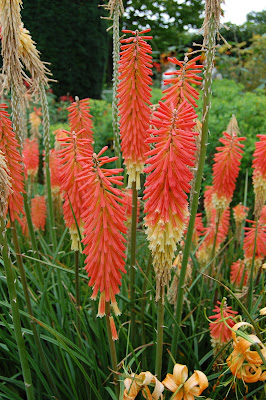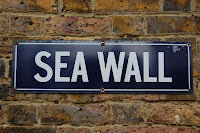
I have wanted to visit Sissinghurst Castle for a long time. I first heard the name when I began reading about Virginia Woolf and the Bloomsbury Group. It was not until sometime later though that I realised that it had a fabulous garden and even then I was not really sure what it would be like. Despite only being a 20 minute drive down the road from where I live and being a member of the National Trust I have only just been to visit it this weekend.
My mum arrived at my house on Saturday morning in time for a quick coffee before we set off to find the castle. The drive down through the Kent countryside is very relaxing with stunning views of the Kent Downs. Sissinghurst village itself is very pretty, we were drawn to the antique shop but resisted and drove down the road to the castle that is just off the main road that runs through the village. It is a very narrow road with 6ft high hedges running along both sides so you have no idea what the castle looks like and it is only once you have parked the car and walked through a small wood that you actually see it.
What I hadn’t appreciated is that the castle is in fact a ruin of a once grand castle. When you first walk up to the castle you can see the tower poking up and you just assume that the rest of the castle is hidden by the building in front of you. It is only when you get through the main gate that you see that the tower is in fact standing on it’s own and there is no castle to be seen!

It has taken many different forms over the hundreds of years that it has been standing and there is quite a good summary here.
We started off by having lunch at the restaurant that is housed in a refurbished barn. The food was delicious, I loved the home made chutney that is made from vegetables that are grown in the garden. They are currently working on producing more home grown food at the site which is great. The windows of the restaurant, large wooden frames that blend into the scenery, allow you to enjoy the pretty view whilst staying in the warm as it was a bit overcast at this point.

I assured Mum that by the time we had finished our lunch the weather would have improved and sure enough, when we set off towards the garden the sun had come out.
For me, the real interest in the garden is the last family of occupants, Vita Sackville-West and her husband Harold Nicholson. I am fascinated by the Bloomsbury set and I have read about Sissinghurst Castle in Virgina Woolf’s diaries. The garden was developed by Vita and Harold and they were inspired by the gardener Gertrude Jekyll. It is set out into lots of different areas, each with its own theme and distinct planting scheme. Some areas are very formal, whilst others are much wilder and flowing. Moving around the garden you get a feel for the different themes that they were trying to achieve in the garden, but this becomes much clearer when you see the views from the tower. You can very clearly see the different areas of the garden and the blocks of colour really stand out. The borders around the edge of the first part of the garden before the tower are absolutely full of plants in contrast to the delicate climbing roses on the wall of the library.

The grass is immaculate and I felt really bad walking across it and wanted to pick up the stray leaf that had blown onto it. The tower itself is a wonderful part of the estate. Vita had her writing room up here and peering in through the door you can see a room full of books as well as her writing desk. The space where she wrote is surrounded by all sorts of little trinkets and large picture of her friend Virginia Woolf. Although the weather had improved there was still quite a breeze at the top of the tower, but what a place to go when you are lacking inspiration.

Having come down from the tower we wandered through into the wilder part of the garden. The grass has been allowed to grow long and there are bee hives dotted about amongst the fruit trees. The original moat of the castle still exists and I think it would be wonderful to row a boat along it on a cool summer evening.

The pavilion at the corner of the garden was built in memory of Harold Nicholson by his sons in 1969 following his death in 1968. From the garden it doesn’t look very impressive, but from the footpath on the edge of the garden you can take a peek inside. Following the moat round you are brought to the more formal area of the garden. This pot here really needed to be taken with a person in the picture, as it was huge, about 4ft tall!

There is certainly plenty of room here for oversized pots without them detracting from the rest of the garden. Winding back down through we found ourselves in the hot garden which also has a cottage in it (which you can see from the top of the tower).

I would be quite happy with a house and garden this size and it really demonstrates how big the estate is that this is just one small part of it. I loved the colour of this pot and the contrast with the orange and green of Osteospermum in it.

The garden really does live up to it’s name as all of the plants in it are deep fiery red and orange colours with touches of pink and yellow too. I would love to see this garden in the winter to see if it still has that warm feeling. We headed back towards the moat and I was pleased to find some borders that were more on my scale. These borders ran the length of the wall and I could see the remains of the alliums that had been planted there. It is about the same width as my borders and I think I will be planting some of this in my garden.

We finished up in the white garden where we spotted this perfectly coloured little white butterfly. The seperation of the gardens by colour really helps to make distinct areas, but the style of planting is also very different. In the white garden the planting is quite informal but each bed is divided up by a very rigid box hedge.

I felt that the garden was almost too big, I was ready for a cup of tea and piece of cake at the restaurant by the time we had walked around. It is definitely one to visit again and again so that you can see how it changes throughout the year and really get to know the different gardens. I don’t know what it would be like to live with. Obviously you would have to have a whole team of people maintaining the site, but I think I would prefer something more on the scale of Charleston. You can very easily get lost at Sissinghurst, and you could spend your whole day not seeing anyone if you wandered off to a quiet part of the garden. I did however get lots of inspiration from the garden and there are several things that I would like to try in my own garden, even if it is on a smaller scale.

One of the unexpected highlights of the day for me was in an exhibition about the history of the castle that we popped into just as we were leaving. In a room about Vita’s friendship with Virginia Woolf there was on display THE “Hogarth Press” (pictured above) that Virginia and Leonard Woolf had used to print some of their early books at Hogarth House in London. Virginia had given it to Vita as a present in 1930. I had seen the printing press when we went into the room, but it was only when I read the information on the wall that it all became clear. I hadn’t quite appreciated that Virginia and Leonard had printed books by hand, page by page, setting the type for each page by hand.
I really enjoyed my day out at Sissinghurst and as I have just renewed my National Trust membership I will be visiting it again soon





